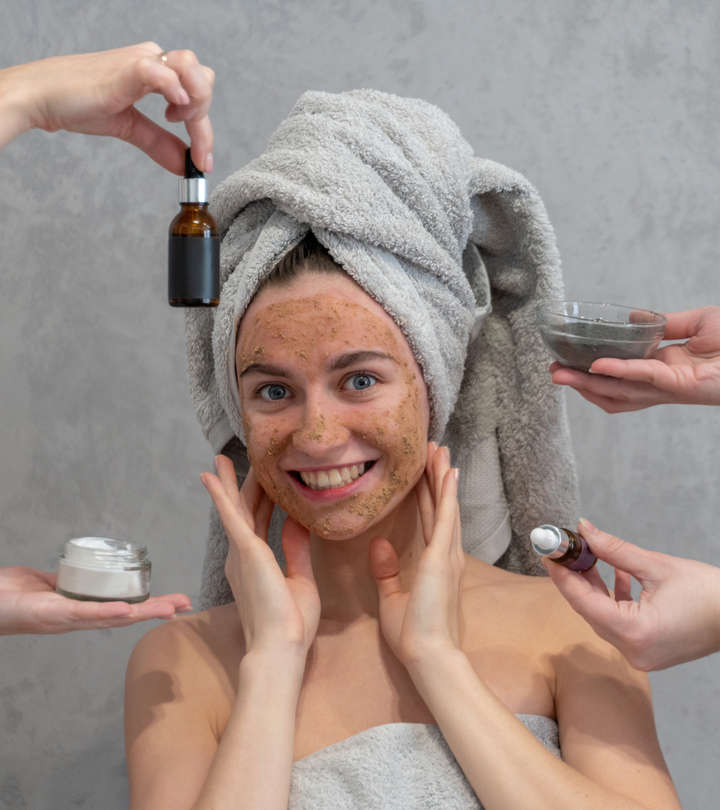Caught up in the physical exfoliation vs. chemical exfoliation debate? Feeling confused about whether to scrub or chemically dissolve the dead skin cells? Don’t worry. We can help. While both effectively improve your skin texture and clear the pores, they may not suit all skin types. To reap the maximum benefits, you need to understand the difference between the two and pick one for your skin type. Keep reading to learn more.
In This Article
What Is Physical Exfoliation?
Physical exfoliation or manual exfoliation is when you have to buff away the dead skin cells manually. Physical exfoliators like scrubs contain grains and gritty materials (like grounded nuts) that gently scrape away the dead skin cells, dirt, and impurities from the skin. This smoothens the skin surface and improves radiance. when done with caution. If not done carefully, it can cause microabrasions..
Other than scrubs, physical exfoliators are available in many different forms like tools (at-home dermaplaning tools) and products like facial sponges.
StyleCraze TriviaAncient Egyptians were among the first people to practice physical exfoliation. It was also observed among the Chinese in the Qing Dynasty (1644–1944).
It is important to note that physical exfoliators are not suitable for all skin types. If you have acne-prone skin, avoid them completely. Let’s understand in detail.
What Type Of Skin Is Best Suited For Physical Exfoliation?
Shutterstock
Physical exfoliation is best suited for body skin, especially the feet, knees, elbows, and fingers. The skin on the body is more resilient than the skin on your decolletage and face.
However, if you prefer scrubs for your face, you may use gentle ones. Avoid physical scrubs if you have acne-prone skin and active lesions, as scrubbing them can aggravate the inflammation. If you are buying commercial scrubs, here are a few ingredients to avoid.
Related: 5 Simple Homemade Scrubs For Dry Skin
Ingredients To Avoid In Physical Exfoliators
Shutterstock
Avoid products that:
- Use large fruit pips and nuts as their large, rough, sharp edges can be harsh on the skin and cause irritation and micro-tears.
- Contain microbeads as they are non-biodegradable and may harm the environment.
- Contain chemicals like phthalates, parabens, SLS, synthetic colors and fragrances, and mineral oil.
Also, consider your skin type when buying physical exfoliators. If you have sensitive skin, use gentle exfoliators.
Chemical exfoliants do not contain abrasive ingredients like physical exfoliants. Let’s understand what they are.
What Is Chemical Exfoliation?
Chemical exfoliation dissolves the bonds between the dead skin cells with the help of chemicals like alpha and beta-hydroxy acids and fruit enzymes.
Chemical exfoliation can help brighten the skin, improve skin texture, and address pigmentation and fine lines. The most common chemical exfoliants are:
- Alpha-Hydroxy Acids: AHAs like glycolic, mandelic, and lactic acids can reduce the signs of photodamage, acne scars, hyperpigmentation, and melasma (1), (2). AHAs can also improve the water holding capacity of the skin (3).
- Beta-Hydroxy Acids: Salicylic acid is the most commonly used BHA that can penetrate the skin to break down the dirt and sebum buildup, promote exfoliation, reduce inflammation, and prevent acne breakouts (4).
- Plant Enzymes: These are best suited for sensitive skin and use plant-derived enzymes (like papain derived from papaya and bromelain from pineapple) to dissolve the top layer of the skin (1).
Doctors often use or prescribe retinoids and retinol-based products to improve skin texture.
Did You Know?Chemical exfoliation also goes by the name ‘chemical peeling.’ Alpha-hydroxy and beta-hydroxy acids are the only exfoliants available for everyday use.
Chemical exfoliants are available in different concentrations. Usually, the OTC exfoliants are milder than the professional medical-grade peels used by doctors. Let’s find out who can use them.
Related: 8 Amazing Benefits Of Alpha Hydroxy Acid For Your Skin
What Type Of Skin Is Best Suited For Chemical Exfoliation?
Shutterstock
Chemical exfoliants suit all skin types, especially oily and acne-prone skin. You can use different types of facial acids for addressing different skin issues and types.
For instance, AHAs are especially beneficial for those who have acne, scarring, and pigmentation. BHA exfoliants are beneficial for acne-prone and oily skin. Enzyme-based exfoliants are much milder than AHA and BHA exfoliants and are suitable for sensitive skin.
These acids are added to different skin care products like face washes, body cleansers, creams, lotions, and serums. They are available in different concentrations. If you are new to chemical exfoliants or have sensitive skin, start with the lowest concentration and gradually increase the strength. You should use chemical exfoliants with caution.
Ingredients To Avoid In Chemical Exfoliators
Avoid the following things when using chemical exfoliators:
- Mixing different chemical exfoliators
- Using different types of exfoliators simultaneously
- Layering exfoliating products (like using a BHA serum after using a BHA or AHA cleanser)
- Using retinol with AHAs, BHAs, and plant enzymes
Whether using physical or chemical exfoliators, you have to be careful about the frequency to avoid irritating your skin.
How Often To Exfoliate
Exfoliate your skin once or twice a week. This is especially when you are using a separate physical scrub or an at-home chemical peel.
Nowadays, almost every other product – right from the cleanser and toner to the serum and moisturizer – contains some chemical exfoliator. Using them all at once can over-exfoliate your skin.
Check the ingredient list before using any product, and avoid using multiple exfoliating products at once.
When used in moderation, physical and chemical exfoliation can benefit your skin in multiple ways.
Benefits Of Exfoliation
Shutterstock
Both physical and chemical exfoliation can:
- Unclog the skin pores, clear dirt and debris from the skin surface, and prevent breakouts.
- Improve the skin texture and make it smooth and soft.
- Help the skin absorb the skin care products better.
- Even out the skin tone by minimizing hyperpigmentation and dark patches and improving the texture.
- Improve skin radiance by boosting cell turnover rate.
On the flip side, there are several risk factors associated with physical and chemical exfoliators.
Physical Exfoliation Vs. Chemical Exfoliation: Side Effects
Physical Exfoliators
Excessive use of physical exfoliators and scrubbing harshly on sensitive and acne-prone skin may cause:
- Micro-tears
- Redness
- Inflammation
- Dry and flaky skin
The gritty particles in physical scrubs may also damage the acne lesions and increase pain and discomfort.
Chemical Exfoliators
Over-exfoliating and using high concentrations of at-home chemical peels without following the precautions may cause:
- Redness
- Dryness
- Stinging and burning sensations
- Hyperpigmentation
- Flaky skin
If you experience any symptoms, understand that either you are over-exfoliating or the exfoliant is too harsh for your skin. Stop using the products immediately, consult a dermatologist, and limit the frequency of exfoliation.
Related: 14 Best Home Remedies For Skin Pigmentation & Prevention Tips
How To Exfoliate The Skin
Shutterstock
If you are using a physical exfoliator or scrub:
- Wash your face or body with water.
- Massage the skin with the scrub gently in circular motions.
- Massage for a minute for the face and at least two minutes if exfoliating the body parts.
- Wash off with lukewarm water.
- Pat your skin dry and moisturize.
If you are using a chemical exfoliator:
- Cleanse your face and pat it dry.
- Apply the at-home chemical peel.
- Leave it on for not more than 10 minutes and wash off with regular water.
- Pat your skin dry and continue with the next skin care steps.
If you are using cleansers, toners, creams, and lotions that contain any of the AHAs, BHAs, and fruit enzymes, follow the instructions on the package.
We hope this article has given you clarity on the physical exfoliation vs. chemical exfoliation debate. Both are good for the skin, but you have to be careful about their usage. You may use physical exfoliants on your body as the body skin is more resilient than facial skin, and you may use chemical exfoliants on your face and décolleté. However, ensure that you are not over-exfoliating the skin. Exfoliate your skin only once or twice a week. As long as you are not over-exfoliating and your skin feels healthy, you may use whichever type of exfoliant you are comfortable with.




